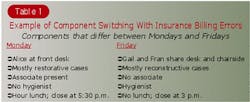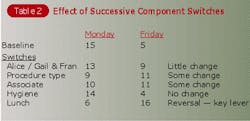Part 9 — Outcomes-based practice ...Component switching
by David W. Chambers, EdM, MBA, PhD
Photo: Pat Dallas at FPG International
Compare the best procedure with the worst procedure and isolate the components that are making the difference.
If you are going to improve your practice, you should start with the most important things — those that make the most difference. Experts in the field of performance excellence call this process component search. There are normally a small number of key levers in practice. First, these levers must be found, then they must be activated. Manipulating the right levers is called component switching.
Dental practice is made up of procedures. There is a root planing procedure, a new-patient acceptance procedure, a supply-ordering procedure, a patient-examination procedure, and so forth. Good practices have good procedures that are consistent with each other. Each procedure is composed of component tasks and operations. Component switching is a method useful for aligning components within procedures.
Let's consider insurance billing. In our hypothetical practice, the dentist is concerned about clerical errors resulting in delayed reimbursement and missed opportunities. In order to identify the components relevant to this process, the front desk records clerical errors and some of the factors associated with them. A Pareto graph shows that the error rate is about three times as high on Fridays as it is on other days of the week. The office uses a fishbone diagram to highlight some of the characteristics of the insurance billing process, particularly on Mondays and Fridays.
This activity isolates several components that the office staff members suspect might be involved; these are listed in Table 1. Individuals performing the insurance billing are one obvious component. On most days, Alice covers the front desk by herself and does the billing. On some days, Gail and Fran cover both the front desk and alternate at chairside. Different professionals are in the office on various days as well. An associate is present on two days and hygiene is performed on four. The office hours differ on Fridays; the staff does not take a formal lunch hour so that the office can close at 3 p.m. Friday is also a day reserved primarily for extensive reconstructive cases.
All of the analysis up to this point has been diagnostic; no blame has been leveled and no improvement plan has been developed. The dentist must strongly resist any tendency to impose a solution based on personal prejudice or on what the literature or consulting experts might say. No one has ever studied this particular office, so outside solutions are risky.
To find out what matters here, a component-switching experiment can be conducted. It can be completed in a month and will require only a few hours — much less time than looking for outside answers and certainly less time than living with repeated insurance billing errors.
In component switching, the strategy is to compare the best procedure with the worst procedure and isolate the components that are making the difference. In this example, the best day is Monday and the worst day is Friday. Counting showed five errors on Monday and 15 on Friday. The suspected components in the Monday and Friday version of the billing process are displayed in Table 1. They are arranged in the order of potential impact, in the dentist's opinion. To have an efficient testing process, it is important to prioritize suspected components.
The procedure for component switching is simple. A baseline (billing errors) is established for the best and worst examples of the procedure. Then the single most suspicious component is switched for the best and worst procedures. The result is calculated, and we look to see if the switch made a difference. If we have switched a vital component, we should expect the outcomes in the practice to be reversed — the former best process should become the worst and vice versa. If we switch a component and no change results, we know we are focusing on a component that is irrelevant to the process. Sometimes a component switch narrows that difference between the best and worst examples without reversing them. In that case, we know we have identified an important component, but not a critical one. Such components should be set aside for further study, because they are modifiers that either enhance a critical component or work in combination with several modifiers to produce a complex result.
In our example, the dentist has assumed that the critical component was the staff. The results of various switches are shown in Table 2. The dentist believes that Fran and Gail are not as well-motivated or well-trained as Alice and has already taken steps to place the Friday staff members on notice and send them to continuing-education courses. (Both remedies are expensive and uncertain, considering the complete lack of evidence. This is Level 0 Learning.) Switching this component — having Alice do the Friday billings and Gail and Fran do the ones for Monday — produces a Monday score of nine errors and a Friday score of 13 in our example. This is a small improvement, but certainly not a reversal of outcomes. The dentist had better rethink the remediation strategy.
Successive components should be switched until a reversal is identified. For illustration, let's assume the dentist now believes the critical component is the nature of the work done on each day. It is a fact that crown-and-bridge insurance cases cause more problems with authorization than do other procedures. Switching crown-and-bridge billings (actual appointments do not have to be switched) from Monday to Friday produces 11 errors on Monday and nine on Friday. There is a reversal here, but a small one — a factor the dentist should consider when refining the process.
Eventually, office hours will be switched. Changing the short, crowded schedule with no lunch hour and an early closing time to Monday instead of Friday produces 16 errors on Monday and six on Friday, a complete reversal of the procedure's effectiveness. The critical component has been isolated. More importantly, applying the correction to the practice is straightforward. Perhaps the simplest solution is to have Alice do insurance billing Monday through Thursday, with no billing on Fridays — better results, no cost, and no recrimination.
After the office makes the switch identified in the component-switching process, everyone will come forward with explanations about how obvious the solution is. Don't be impressed, unless you need something to boost office morale. Successes are popular and failures are orphans. Credit and theorizing are rationalizations. What matters is that the office works more effectively when the components are properly aligned, and some switching (while watching outcomes) is a sound way to do that. Remember, though, not to stop when minor improvements are found; instead, look for switches that substantially change the order of things.
Professionals make useful and beautiful things. Component switching is not research in the usual sense; it actually makes something more useful and beautiful. It is also a healthy antidote to unconfirmed dogmatism — "Do it my way because I am smarter than you are."



